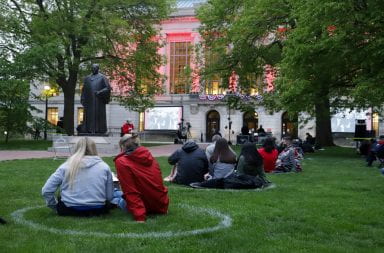More than 78 robots, built by first-year engineering students, raced the clock to win top honors Thursday at St. John Arena.
The Fundamentals of Engineering for Honors annual robot competition matched tiny machines against one other. Teams had to build and program their robots to precise standards. And the course challenged the robots with several tasks, each one dependent on the one before.
First-year students were given a handiboard, similar to a motherboard on a computer, and $160 in credit for parts from the school storeroom. Then, each team built its robot and coded the handiboard to meet the specifications of the competition.
The competition’s course was a knee-high platform with four starting grids, one for each robot. Using light sensors and overhead GPS signals, the machines had to plug a hole to raise a bar for access to a switch activating a wind turbine. The robot then turned a solar panel and scampered back to its starting point, again using light signals that changed with each heat of the competition.
The G-5 team was made up of Jimmy Devine, a computer science engineering student from Worthington, Ohio; Lydia Griffith, a chemical engineering student from Cincinnati; Esther Wong, a chemical engineering student from Worthington; and Nathan Braid, a mechanical engineering student from Pickerington.
Devine coded the G-5 robot.
“We had only 20 KB (kilobytes) to work with,” he said. “A home computer has about 200,000 times as much. G-5 had 19.6 KB already, so I didn’t have much left over.”
Beth Yoak, a second-year in mechanical and systems engineering from Grove City and a teaching assistant, explained the course’s design.
“Robots have to fit inside a 9-by-9-inch box,” Yoak said. “The course is designed by the TAs to demonstrate green initiatives. The winning robot is the most efficient one.”
Dick Busick, a lecturer in the College of Engineering, described the challenge.
“The robots are autonomous,” Busick said. “Once the student puts it on the course, it operates according to its coding. An important part of the project is documentation. If it’s not documented, it didn’t happen.”
At the sweet 16 level, the G-5 team had a scare. Just short of a successful run, the robot caught a gap on the platform, causing its 3-inch wheel to spin.
“I know exactly what the problem is,” programmer Devine said. “The robot wasn’t supposed to turn that soon. I adjusted the code, and that should fix it.”
G-5 made it to the final four. Then, just after 6 p.m., four robots lined up head-to-handiboard, and the race was on. Motors whirred, lights flashed, and tasks fell away as coding did its job. Then G-5 backed into its light-coded stall. It was the first to finish, and the G-5 team won.


